Significance of Emerging Internet Technologies in AirAsia E-Commerce
VerifiedAdded on 2021/06/18
|18
|5294
|33
Report
AI Summary
This report examines the significance of e-commerce in the context of AirAsia airline. It begins with an analysis of e-commerce, defining its role and importance in modern business strategies, followed by an overview of AirAsia's current e-business activities. The report then proposes and justifies a system architecture to support e-business, exploring how AirAsia has developed its e-commerce capabilities, including its online booking system. It also delves into the benefits and disadvantages of e-commerce for AirAsia, concluding with an assessment of the impact of emerging internet technologies. The report provides insights into AirAsia's strategic approach to e-commerce, highlighting its evolution and the challenges it faces in the competitive airline industry. The analysis covers various aspects, from online transactions to the adoption of new technologies, and their impact on AirAsia's business model and customer experience.
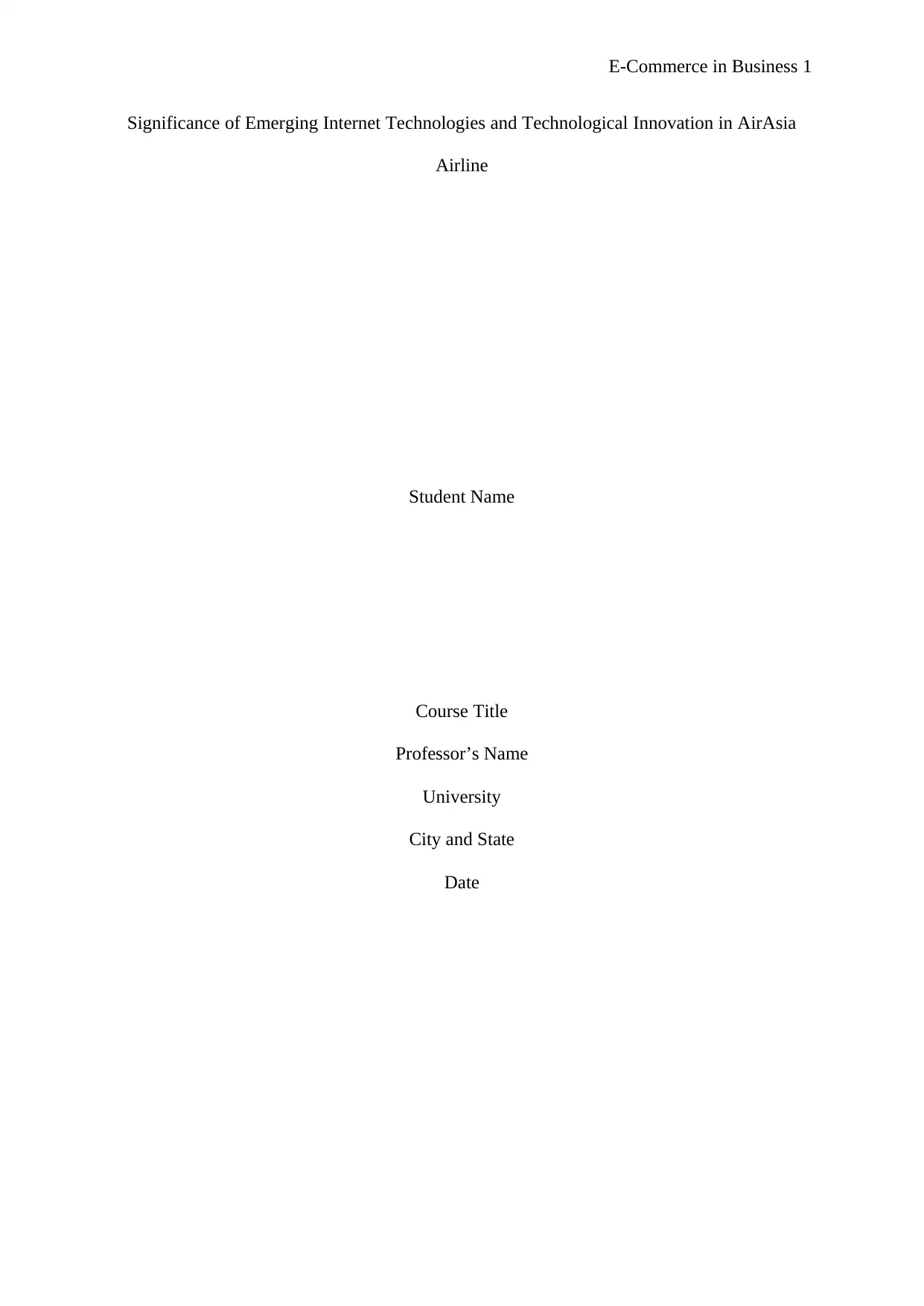
E-Commerce in Business 1
Significance of Emerging Internet Technologies and Technological Innovation in AirAsia
Airline
Student Name
Course Title
Professor’s Name
University
City and State
Date
Significance of Emerging Internet Technologies and Technological Innovation in AirAsia
Airline
Student Name
Course Title
Professor’s Name
University
City and State
Date
Paraphrase This Document
Need a fresh take? Get an instant paraphrase of this document with our AI Paraphraser
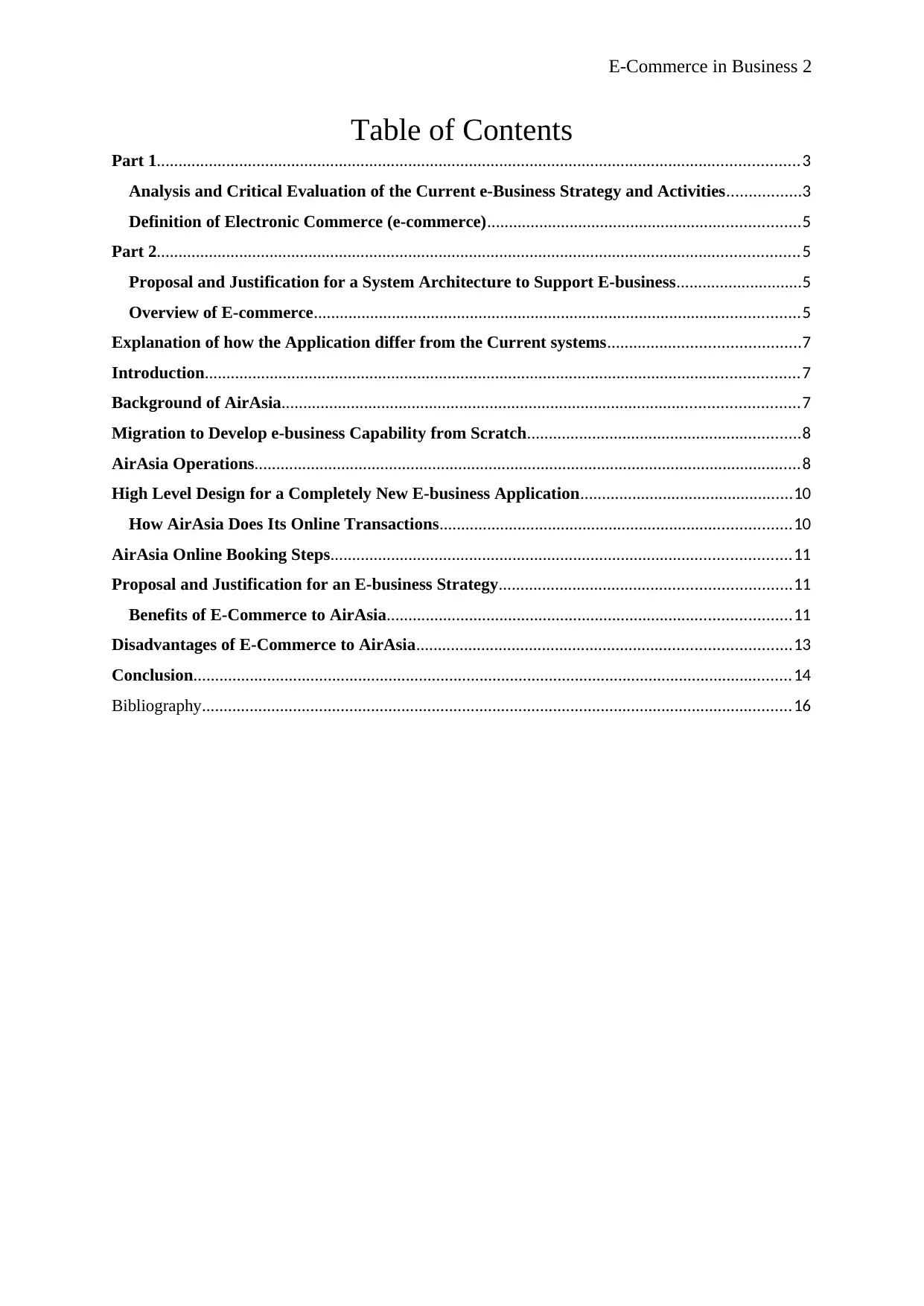
E-Commerce in Business 2
Table of Contents
Part 1....................................................................................................................................................3
Analysis and Critical Evaluation of the Current e-Business Strategy and Activities.................3
Definition of Electronic Commerce (e-commerce)........................................................................5
Part 2....................................................................................................................................................5
Proposal and Justification for a System Architecture to Support E-business.............................5
Overview of E-commerce................................................................................................................5
Explanation of how the Application differ from the Current systems............................................7
Introduction.........................................................................................................................................7
Background of AirAsia.......................................................................................................................7
Migration to Develop e-business Capability from Scratch...............................................................8
AirAsia Operations..............................................................................................................................8
High Level Design for a Completely New E-business Application.................................................10
How AirAsia Does Its Online Transactions.................................................................................10
AirAsia Online Booking Steps..........................................................................................................11
Proposal and Justification for an E-business Strategy...................................................................11
Benefits of E-Commerce to AirAsia.............................................................................................11
Disadvantages of E-Commerce to AirAsia......................................................................................13
Conclusion..........................................................................................................................................14
Bibliography........................................................................................................................................16
Table of Contents
Part 1....................................................................................................................................................3
Analysis and Critical Evaluation of the Current e-Business Strategy and Activities.................3
Definition of Electronic Commerce (e-commerce)........................................................................5
Part 2....................................................................................................................................................5
Proposal and Justification for a System Architecture to Support E-business.............................5
Overview of E-commerce................................................................................................................5
Explanation of how the Application differ from the Current systems............................................7
Introduction.........................................................................................................................................7
Background of AirAsia.......................................................................................................................7
Migration to Develop e-business Capability from Scratch...............................................................8
AirAsia Operations..............................................................................................................................8
High Level Design for a Completely New E-business Application.................................................10
How AirAsia Does Its Online Transactions.................................................................................10
AirAsia Online Booking Steps..........................................................................................................11
Proposal and Justification for an E-business Strategy...................................................................11
Benefits of E-Commerce to AirAsia.............................................................................................11
Disadvantages of E-Commerce to AirAsia......................................................................................13
Conclusion..........................................................................................................................................14
Bibliography........................................................................................................................................16
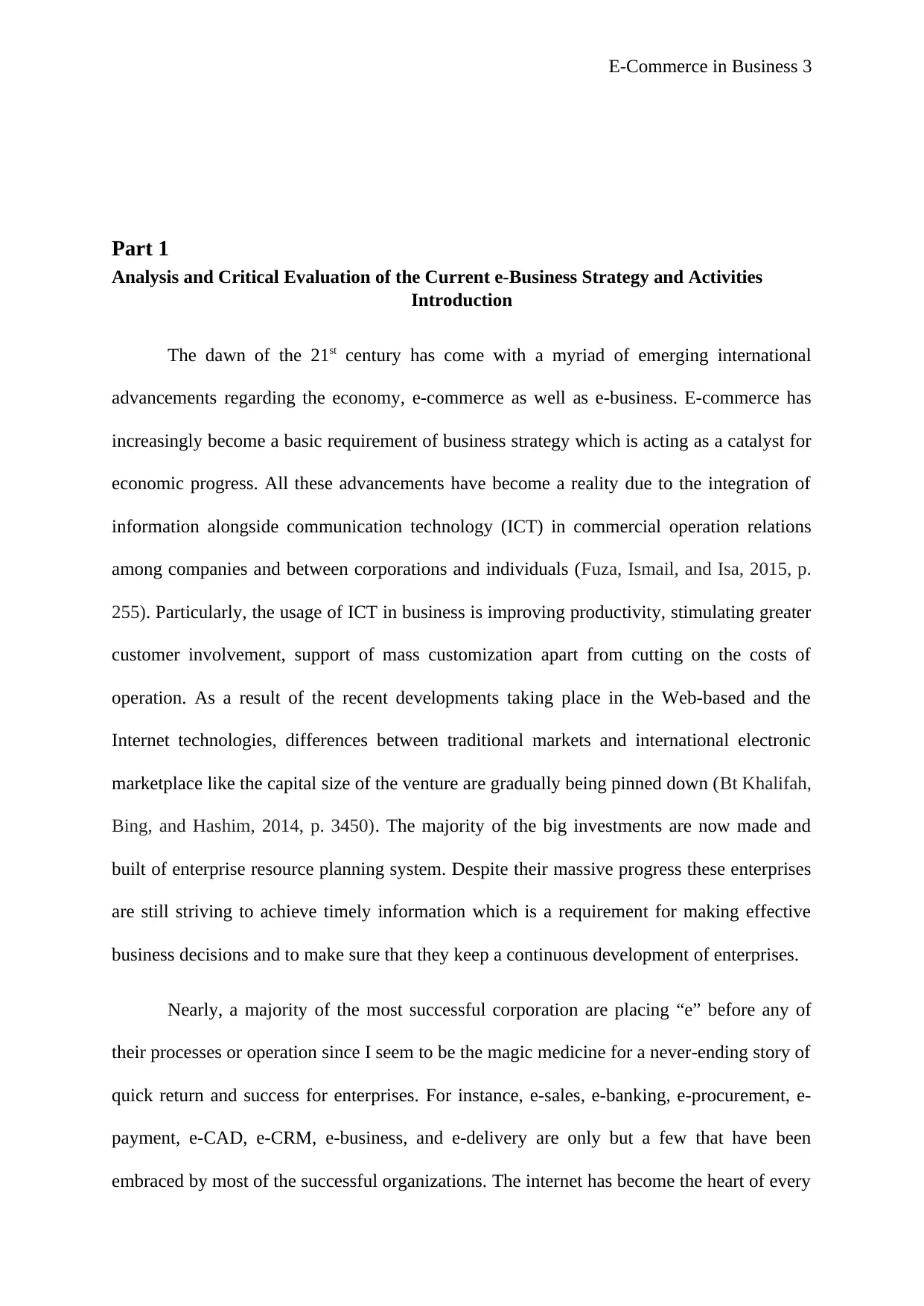
E-Commerce in Business 3
Part 1
Analysis and Critical Evaluation of the Current e-Business Strategy and Activities
Introduction
The dawn of the 21st century has come with a myriad of emerging international
advancements regarding the economy, e-commerce as well as e-business. E-commerce has
increasingly become a basic requirement of business strategy which is acting as a catalyst for
economic progress. All these advancements have become a reality due to the integration of
information alongside communication technology (ICT) in commercial operation relations
among companies and between corporations and individuals (Fuza, Ismail, and Isa, 2015, p.
255). Particularly, the usage of ICT in business is improving productivity, stimulating greater
customer involvement, support of mass customization apart from cutting on the costs of
operation. As a result of the recent developments taking place in the Web-based and the
Internet technologies, differences between traditional markets and international electronic
marketplace like the capital size of the venture are gradually being pinned down (Bt Khalifah,
Bing, and Hashim, 2014, p. 3450). The majority of the big investments are now made and
built of enterprise resource planning system. Despite their massive progress these enterprises
are still striving to achieve timely information which is a requirement for making effective
business decisions and to make sure that they keep a continuous development of enterprises.
Nearly, a majority of the most successful corporation are placing “e” before any of
their processes or operation since I seem to be the magic medicine for a never-ending story of
quick return and success for enterprises. For instance, e-sales, e-banking, e-procurement, e-
payment, e-CAD, e-CRM, e-business, and e-delivery are only but a few that have been
embraced by most of the successful organizations. The internet has become the heart of every
Part 1
Analysis and Critical Evaluation of the Current e-Business Strategy and Activities
Introduction
The dawn of the 21st century has come with a myriad of emerging international
advancements regarding the economy, e-commerce as well as e-business. E-commerce has
increasingly become a basic requirement of business strategy which is acting as a catalyst for
economic progress. All these advancements have become a reality due to the integration of
information alongside communication technology (ICT) in commercial operation relations
among companies and between corporations and individuals (Fuza, Ismail, and Isa, 2015, p.
255). Particularly, the usage of ICT in business is improving productivity, stimulating greater
customer involvement, support of mass customization apart from cutting on the costs of
operation. As a result of the recent developments taking place in the Web-based and the
Internet technologies, differences between traditional markets and international electronic
marketplace like the capital size of the venture are gradually being pinned down (Bt Khalifah,
Bing, and Hashim, 2014, p. 3450). The majority of the big investments are now made and
built of enterprise resource planning system. Despite their massive progress these enterprises
are still striving to achieve timely information which is a requirement for making effective
business decisions and to make sure that they keep a continuous development of enterprises.
Nearly, a majority of the most successful corporation are placing “e” before any of
their processes or operation since I seem to be the magic medicine for a never-ending story of
quick return and success for enterprises. For instance, e-sales, e-banking, e-procurement, e-
payment, e-CAD, e-CRM, e-business, and e-delivery are only but a few that have been
embraced by most of the successful organizations. The internet has become the heart of every
⊘ This is a preview!⊘
Do you want full access?
Subscribe today to unlock all pages.

Trusted by 1+ million students worldwide
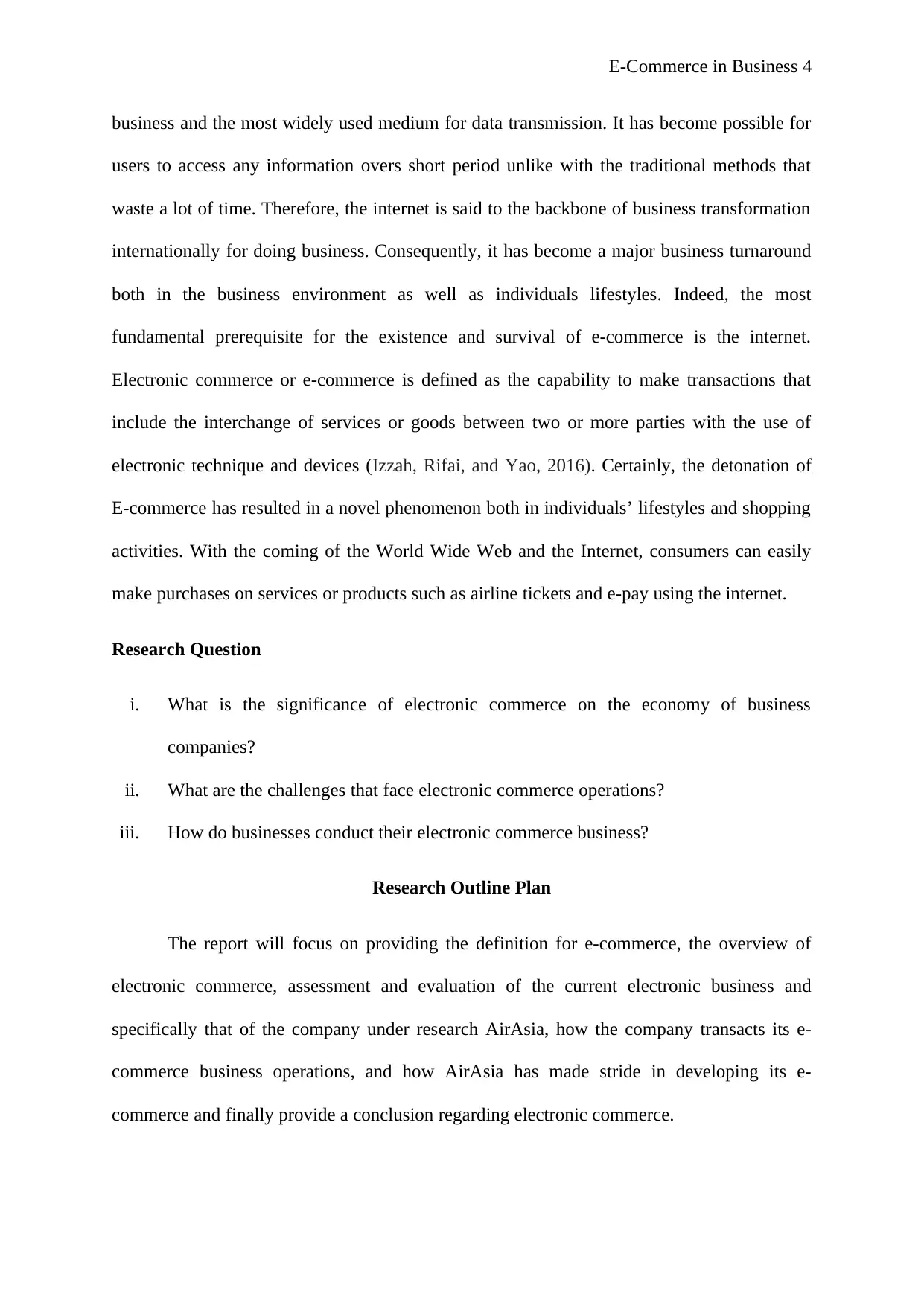
E-Commerce in Business 4
business and the most widely used medium for data transmission. It has become possible for
users to access any information overs short period unlike with the traditional methods that
waste a lot of time. Therefore, the internet is said to the backbone of business transformation
internationally for doing business. Consequently, it has become a major business turnaround
both in the business environment as well as individuals lifestyles. Indeed, the most
fundamental prerequisite for the existence and survival of e-commerce is the internet.
Electronic commerce or e-commerce is defined as the capability to make transactions that
include the interchange of services or goods between two or more parties with the use of
electronic technique and devices (Izzah, Rifai, and Yao, 2016). Certainly, the detonation of
E-commerce has resulted in a novel phenomenon both in individuals’ lifestyles and shopping
activities. With the coming of the World Wide Web and the Internet, consumers can easily
make purchases on services or products such as airline tickets and e-pay using the internet.
Research Question
i. What is the significance of electronic commerce on the economy of business
companies?
ii. What are the challenges that face electronic commerce operations?
iii. How do businesses conduct their electronic commerce business?
Research Outline Plan
The report will focus on providing the definition for e-commerce, the overview of
electronic commerce, assessment and evaluation of the current electronic business and
specifically that of the company under research AirAsia, how the company transacts its e-
commerce business operations, and how AirAsia has made stride in developing its e-
commerce and finally provide a conclusion regarding electronic commerce.
business and the most widely used medium for data transmission. It has become possible for
users to access any information overs short period unlike with the traditional methods that
waste a lot of time. Therefore, the internet is said to the backbone of business transformation
internationally for doing business. Consequently, it has become a major business turnaround
both in the business environment as well as individuals lifestyles. Indeed, the most
fundamental prerequisite for the existence and survival of e-commerce is the internet.
Electronic commerce or e-commerce is defined as the capability to make transactions that
include the interchange of services or goods between two or more parties with the use of
electronic technique and devices (Izzah, Rifai, and Yao, 2016). Certainly, the detonation of
E-commerce has resulted in a novel phenomenon both in individuals’ lifestyles and shopping
activities. With the coming of the World Wide Web and the Internet, consumers can easily
make purchases on services or products such as airline tickets and e-pay using the internet.
Research Question
i. What is the significance of electronic commerce on the economy of business
companies?
ii. What are the challenges that face electronic commerce operations?
iii. How do businesses conduct their electronic commerce business?
Research Outline Plan
The report will focus on providing the definition for e-commerce, the overview of
electronic commerce, assessment and evaluation of the current electronic business and
specifically that of the company under research AirAsia, how the company transacts its e-
commerce business operations, and how AirAsia has made stride in developing its e-
commerce and finally provide a conclusion regarding electronic commerce.
Paraphrase This Document
Need a fresh take? Get an instant paraphrase of this document with our AI Paraphraser
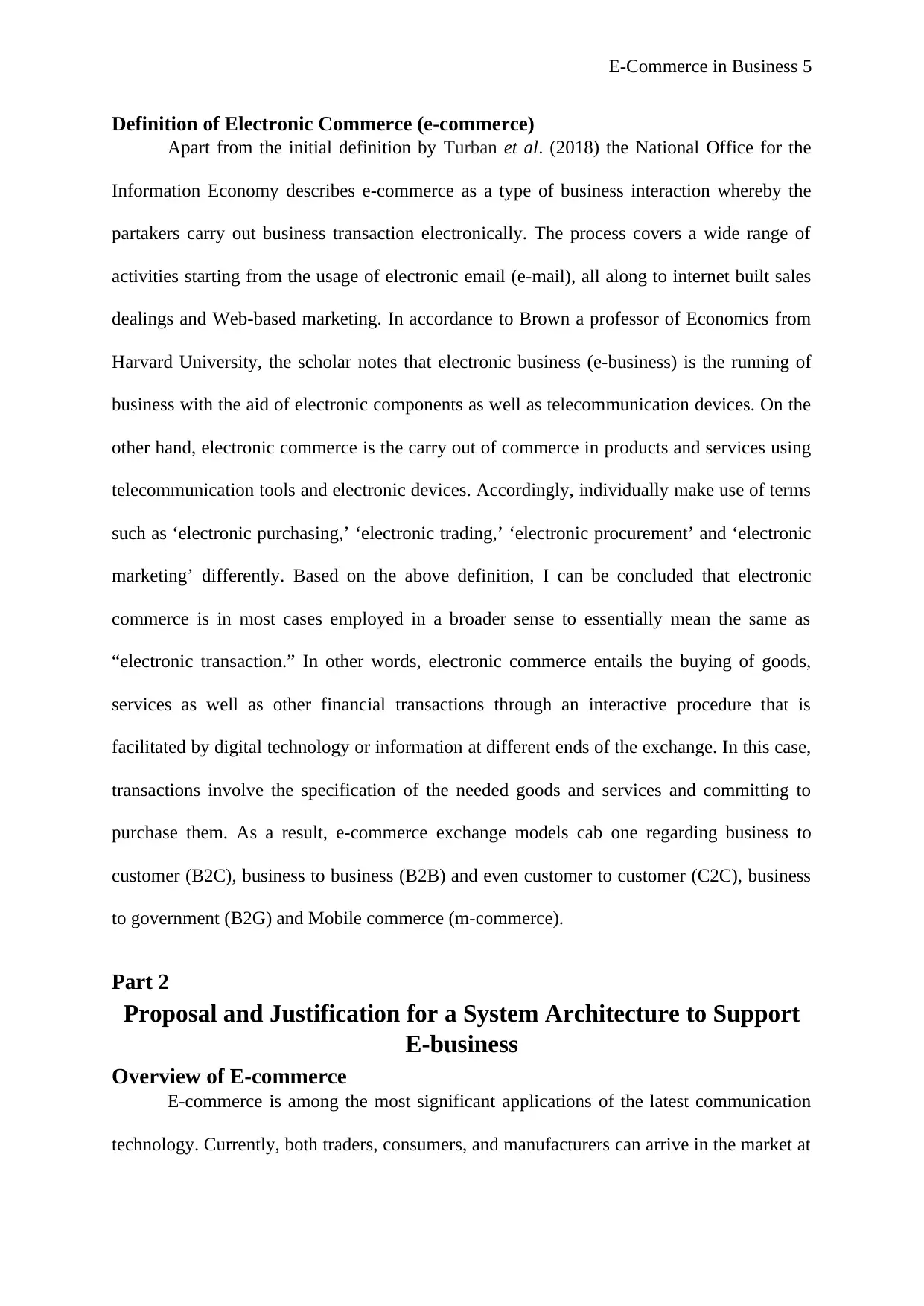
E-Commerce in Business 5
Definition of Electronic Commerce (e-commerce)
Apart from the initial definition by Turban et al. (2018) the National Office for the
Information Economy describes e-commerce as a type of business interaction whereby the
partakers carry out business transaction electronically. The process covers a wide range of
activities starting from the usage of electronic email (e-mail), all along to internet built sales
dealings and Web-based marketing. In accordance to Brown a professor of Economics from
Harvard University, the scholar notes that electronic business (e-business) is the running of
business with the aid of electronic components as well as telecommunication devices. On the
other hand, electronic commerce is the carry out of commerce in products and services using
telecommunication tools and electronic devices. Accordingly, individually make use of terms
such as ‘electronic purchasing,’ ‘electronic trading,’ ‘electronic procurement’ and ‘electronic
marketing’ differently. Based on the above definition, I can be concluded that electronic
commerce is in most cases employed in a broader sense to essentially mean the same as
“electronic transaction.” In other words, electronic commerce entails the buying of goods,
services as well as other financial transactions through an interactive procedure that is
facilitated by digital technology or information at different ends of the exchange. In this case,
transactions involve the specification of the needed goods and services and committing to
purchase them. As a result, e-commerce exchange models cab one regarding business to
customer (B2C), business to business (B2B) and even customer to customer (C2C), business
to government (B2G) and Mobile commerce (m-commerce).
Part 2
Proposal and Justification for a System Architecture to Support
E-business
Overview of E-commerce
E-commerce is among the most significant applications of the latest communication
technology. Currently, both traders, consumers, and manufacturers can arrive in the market at
Definition of Electronic Commerce (e-commerce)
Apart from the initial definition by Turban et al. (2018) the National Office for the
Information Economy describes e-commerce as a type of business interaction whereby the
partakers carry out business transaction electronically. The process covers a wide range of
activities starting from the usage of electronic email (e-mail), all along to internet built sales
dealings and Web-based marketing. In accordance to Brown a professor of Economics from
Harvard University, the scholar notes that electronic business (e-business) is the running of
business with the aid of electronic components as well as telecommunication devices. On the
other hand, electronic commerce is the carry out of commerce in products and services using
telecommunication tools and electronic devices. Accordingly, individually make use of terms
such as ‘electronic purchasing,’ ‘electronic trading,’ ‘electronic procurement’ and ‘electronic
marketing’ differently. Based on the above definition, I can be concluded that electronic
commerce is in most cases employed in a broader sense to essentially mean the same as
“electronic transaction.” In other words, electronic commerce entails the buying of goods,
services as well as other financial transactions through an interactive procedure that is
facilitated by digital technology or information at different ends of the exchange. In this case,
transactions involve the specification of the needed goods and services and committing to
purchase them. As a result, e-commerce exchange models cab one regarding business to
customer (B2C), business to business (B2B) and even customer to customer (C2C), business
to government (B2G) and Mobile commerce (m-commerce).
Part 2
Proposal and Justification for a System Architecture to Support
E-business
Overview of E-commerce
E-commerce is among the most significant applications of the latest communication
technology. Currently, both traders, consumers, and manufacturers can arrive in the market at
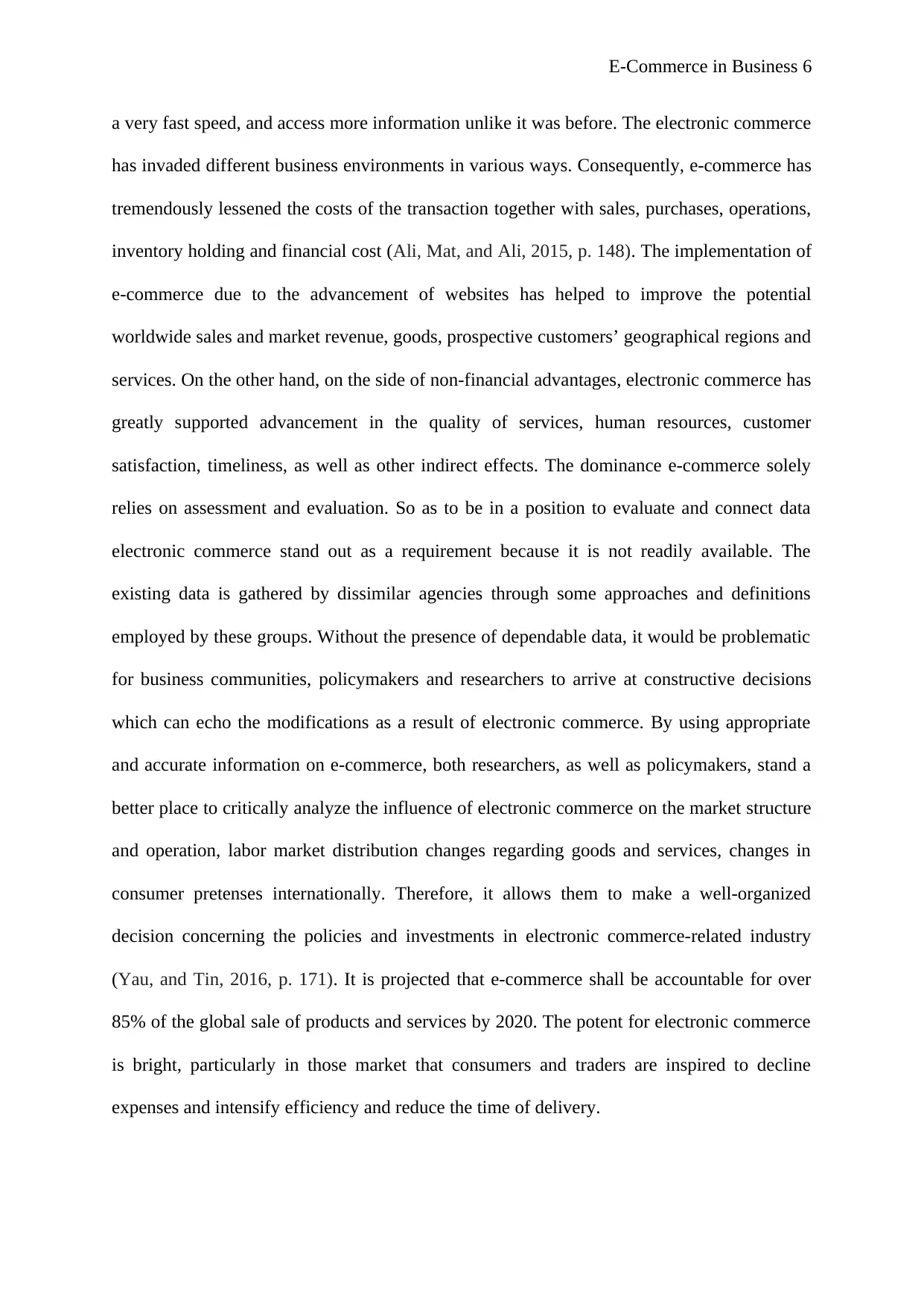
E-Commerce in Business 6
a very fast speed, and access more information unlike it was before. The electronic commerce
has invaded different business environments in various ways. Consequently, e-commerce has
tremendously lessened the costs of the transaction together with sales, purchases, operations,
inventory holding and financial cost (Ali, Mat, and Ali, 2015, p. 148). The implementation of
e-commerce due to the advancement of websites has helped to improve the potential
worldwide sales and market revenue, goods, prospective customers’ geographical regions and
services. On the other hand, on the side of non-financial advantages, electronic commerce has
greatly supported advancement in the quality of services, human resources, customer
satisfaction, timeliness, as well as other indirect effects. The dominance e-commerce solely
relies on assessment and evaluation. So as to be in a position to evaluate and connect data
electronic commerce stand out as a requirement because it is not readily available. The
existing data is gathered by dissimilar agencies through some approaches and definitions
employed by these groups. Without the presence of dependable data, it would be problematic
for business communities, policymakers and researchers to arrive at constructive decisions
which can echo the modifications as a result of electronic commerce. By using appropriate
and accurate information on e-commerce, both researchers, as well as policymakers, stand a
better place to critically analyze the influence of electronic commerce on the market structure
and operation, labor market distribution changes regarding goods and services, changes in
consumer pretenses internationally. Therefore, it allows them to make a well-organized
decision concerning the policies and investments in electronic commerce-related industry
(Yau, and Tin, 2016, p. 171). It is projected that e-commerce shall be accountable for over
85% of the global sale of products and services by 2020. The potent for electronic commerce
is bright, particularly in those market that consumers and traders are inspired to decline
expenses and intensify efficiency and reduce the time of delivery.
a very fast speed, and access more information unlike it was before. The electronic commerce
has invaded different business environments in various ways. Consequently, e-commerce has
tremendously lessened the costs of the transaction together with sales, purchases, operations,
inventory holding and financial cost (Ali, Mat, and Ali, 2015, p. 148). The implementation of
e-commerce due to the advancement of websites has helped to improve the potential
worldwide sales and market revenue, goods, prospective customers’ geographical regions and
services. On the other hand, on the side of non-financial advantages, electronic commerce has
greatly supported advancement in the quality of services, human resources, customer
satisfaction, timeliness, as well as other indirect effects. The dominance e-commerce solely
relies on assessment and evaluation. So as to be in a position to evaluate and connect data
electronic commerce stand out as a requirement because it is not readily available. The
existing data is gathered by dissimilar agencies through some approaches and definitions
employed by these groups. Without the presence of dependable data, it would be problematic
for business communities, policymakers and researchers to arrive at constructive decisions
which can echo the modifications as a result of electronic commerce. By using appropriate
and accurate information on e-commerce, both researchers, as well as policymakers, stand a
better place to critically analyze the influence of electronic commerce on the market structure
and operation, labor market distribution changes regarding goods and services, changes in
consumer pretenses internationally. Therefore, it allows them to make a well-organized
decision concerning the policies and investments in electronic commerce-related industry
(Yau, and Tin, 2016, p. 171). It is projected that e-commerce shall be accountable for over
85% of the global sale of products and services by 2020. The potent for electronic commerce
is bright, particularly in those market that consumers and traders are inspired to decline
expenses and intensify efficiency and reduce the time of delivery.
⊘ This is a preview!⊘
Do you want full access?
Subscribe today to unlock all pages.

Trusted by 1+ million students worldwide
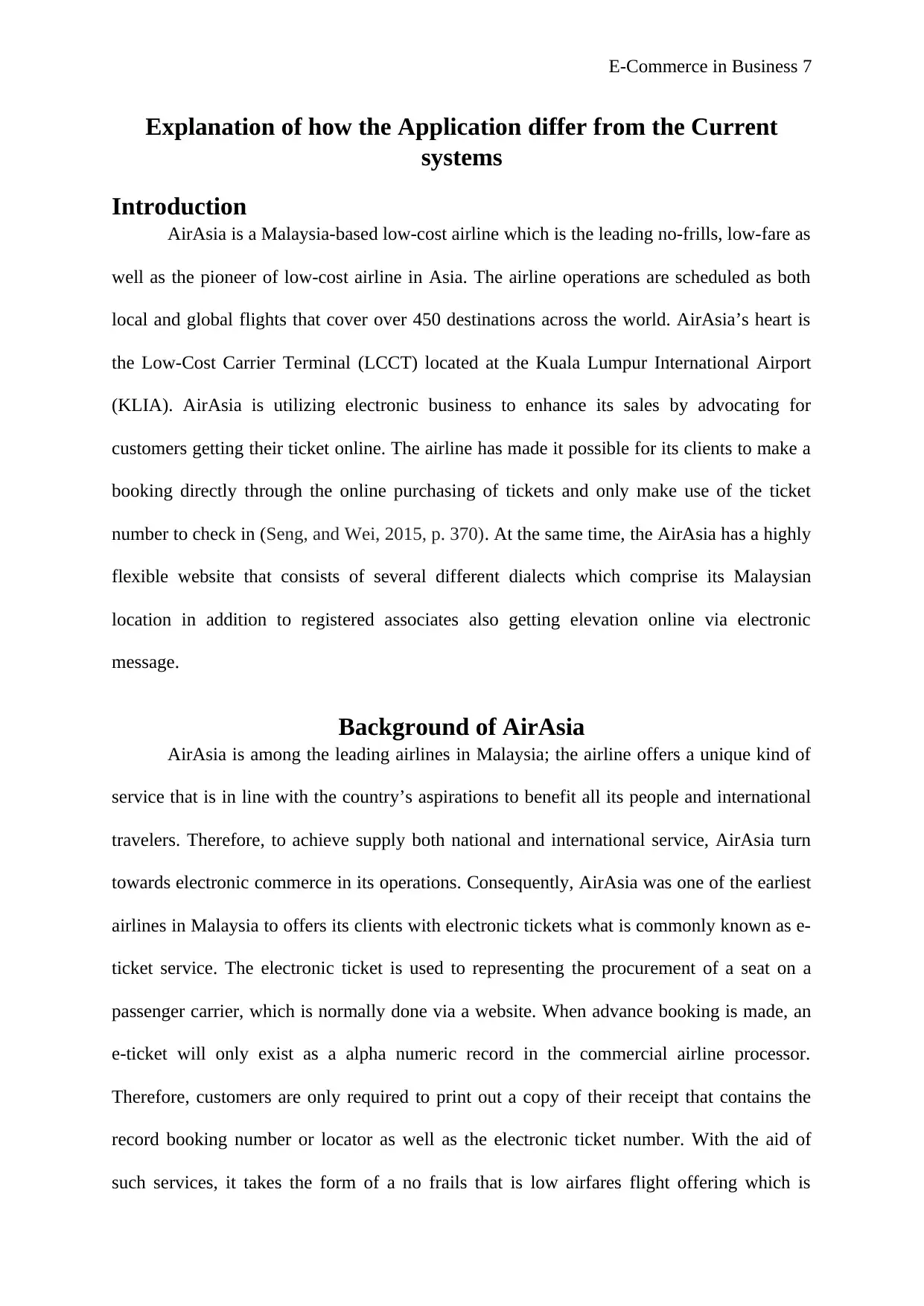
E-Commerce in Business 7
Explanation of how the Application differ from the Current
systems
Introduction
AirAsia is a Malaysia-based low-cost airline which is the leading no-frills, low-fare as
well as the pioneer of low-cost airline in Asia. The airline operations are scheduled as both
local and global flights that cover over 450 destinations across the world. AirAsia’s heart is
the Low-Cost Carrier Terminal (LCCT) located at the Kuala Lumpur International Airport
(KLIA). AirAsia is utilizing electronic business to enhance its sales by advocating for
customers getting their ticket online. The airline has made it possible for its clients to make a
booking directly through the online purchasing of tickets and only make use of the ticket
number to check in (Seng, and Wei, 2015, p. 370). At the same time, the AirAsia has a highly
flexible website that consists of several different dialects which comprise its Malaysian
location in addition to registered associates also getting elevation online via electronic
message.
Background of AirAsia
AirAsia is among the leading airlines in Malaysia; the airline offers a unique kind of
service that is in line with the country’s aspirations to benefit all its people and international
travelers. Therefore, to achieve supply both national and international service, AirAsia turn
towards electronic commerce in its operations. Consequently, AirAsia was one of the earliest
airlines in Malaysia to offers its clients with electronic tickets what is commonly known as e-
ticket service. The electronic ticket is used to representing the procurement of a seat on a
passenger carrier, which is normally done via a website. When advance booking is made, an
e-ticket will only exist as a alpha numeric record in the commercial airline processor.
Therefore, customers are only required to print out a copy of their receipt that contains the
record booking number or locator as well as the electronic ticket number. With the aid of
such services, it takes the form of a no frails that is low airfares flight offering which is
Explanation of how the Application differ from the Current
systems
Introduction
AirAsia is a Malaysia-based low-cost airline which is the leading no-frills, low-fare as
well as the pioneer of low-cost airline in Asia. The airline operations are scheduled as both
local and global flights that cover over 450 destinations across the world. AirAsia’s heart is
the Low-Cost Carrier Terminal (LCCT) located at the Kuala Lumpur International Airport
(KLIA). AirAsia is utilizing electronic business to enhance its sales by advocating for
customers getting their ticket online. The airline has made it possible for its clients to make a
booking directly through the online purchasing of tickets and only make use of the ticket
number to check in (Seng, and Wei, 2015, p. 370). At the same time, the AirAsia has a highly
flexible website that consists of several different dialects which comprise its Malaysian
location in addition to registered associates also getting elevation online via electronic
message.
Background of AirAsia
AirAsia is among the leading airlines in Malaysia; the airline offers a unique kind of
service that is in line with the country’s aspirations to benefit all its people and international
travelers. Therefore, to achieve supply both national and international service, AirAsia turn
towards electronic commerce in its operations. Consequently, AirAsia was one of the earliest
airlines in Malaysia to offers its clients with electronic tickets what is commonly known as e-
ticket service. The electronic ticket is used to representing the procurement of a seat on a
passenger carrier, which is normally done via a website. When advance booking is made, an
e-ticket will only exist as a alpha numeric record in the commercial airline processor.
Therefore, customers are only required to print out a copy of their receipt that contains the
record booking number or locator as well as the electronic ticket number. With the aid of
such services, it takes the form of a no frails that is low airfares flight offering which is
Paraphrase This Document
Need a fresh take? Get an instant paraphrase of this document with our AI Paraphraser
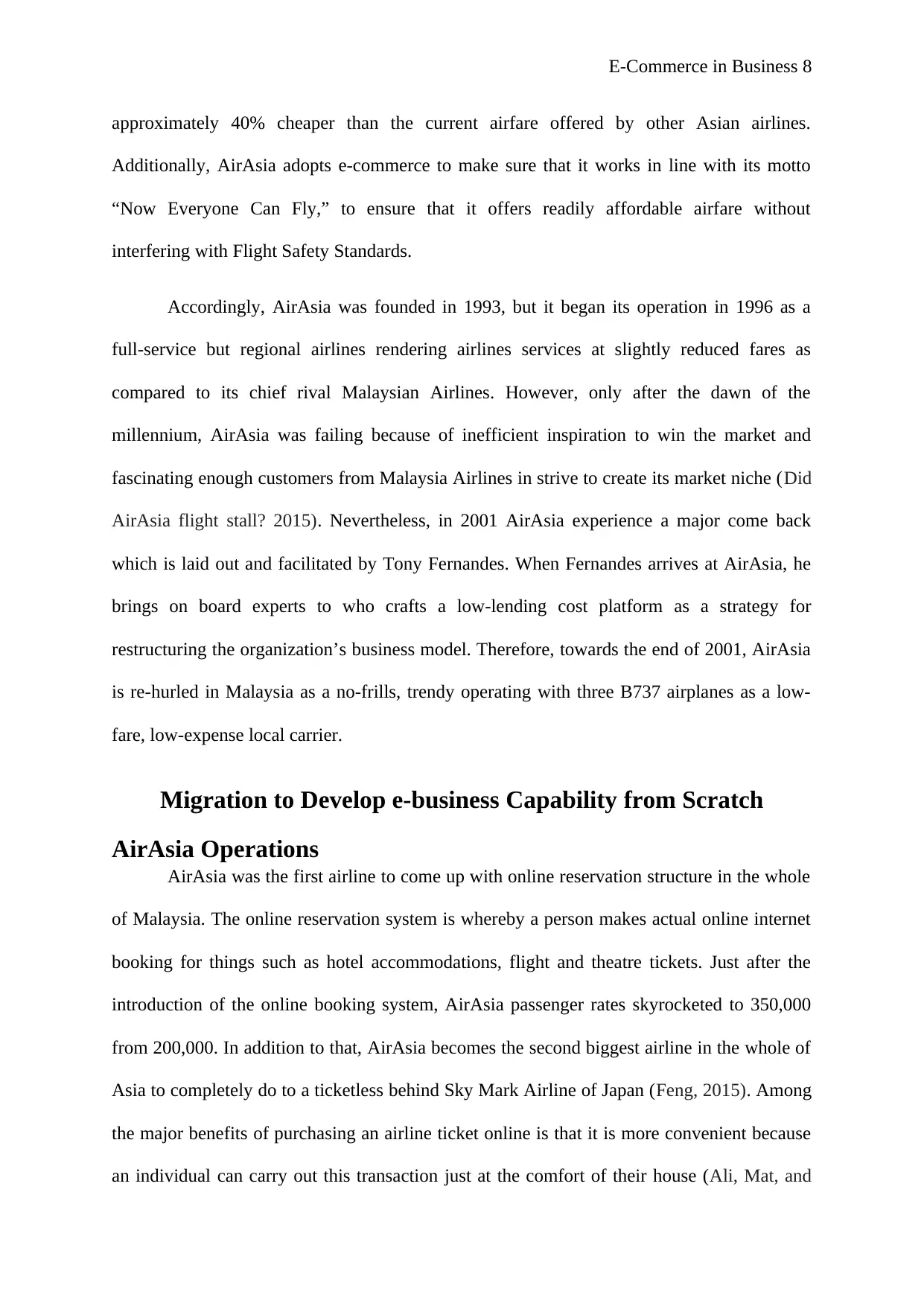
E-Commerce in Business 8
approximately 40% cheaper than the current airfare offered by other Asian airlines.
Additionally, AirAsia adopts e-commerce to make sure that it works in line with its motto
“Now Everyone Can Fly,” to ensure that it offers readily affordable airfare without
interfering with Flight Safety Standards.
Accordingly, AirAsia was founded in 1993, but it began its operation in 1996 as a
full-service but regional airlines rendering airlines services at slightly reduced fares as
compared to its chief rival Malaysian Airlines. However, only after the dawn of the
millennium, AirAsia was failing because of inefficient inspiration to win the market and
fascinating enough customers from Malaysia Airlines in strive to create its market niche (Did
AirAsia flight stall? 2015). Nevertheless, in 2001 AirAsia experience a major come back
which is laid out and facilitated by Tony Fernandes. When Fernandes arrives at AirAsia, he
brings on board experts to who crafts a low-lending cost platform as a strategy for
restructuring the organization’s business model. Therefore, towards the end of 2001, AirAsia
is re-hurled in Malaysia as a no-frills, trendy operating with three B737 airplanes as a low-
fare, low-expense local carrier.
Migration to Develop e-business Capability from Scratch
AirAsia Operations
AirAsia was the first airline to come up with online reservation structure in the whole
of Malaysia. The online reservation system is whereby a person makes actual online internet
booking for things such as hotel accommodations, flight and theatre tickets. Just after the
introduction of the online booking system, AirAsia passenger rates skyrocketed to 350,000
from 200,000. In addition to that, AirAsia becomes the second biggest airline in the whole of
Asia to completely do to a ticketless behind Sky Mark Airline of Japan (Feng, 2015). Among
the major benefits of purchasing an airline ticket online is that it is more convenient because
an individual can carry out this transaction just at the comfort of their house (Ali, Mat, and
approximately 40% cheaper than the current airfare offered by other Asian airlines.
Additionally, AirAsia adopts e-commerce to make sure that it works in line with its motto
“Now Everyone Can Fly,” to ensure that it offers readily affordable airfare without
interfering with Flight Safety Standards.
Accordingly, AirAsia was founded in 1993, but it began its operation in 1996 as a
full-service but regional airlines rendering airlines services at slightly reduced fares as
compared to its chief rival Malaysian Airlines. However, only after the dawn of the
millennium, AirAsia was failing because of inefficient inspiration to win the market and
fascinating enough customers from Malaysia Airlines in strive to create its market niche (Did
AirAsia flight stall? 2015). Nevertheless, in 2001 AirAsia experience a major come back
which is laid out and facilitated by Tony Fernandes. When Fernandes arrives at AirAsia, he
brings on board experts to who crafts a low-lending cost platform as a strategy for
restructuring the organization’s business model. Therefore, towards the end of 2001, AirAsia
is re-hurled in Malaysia as a no-frills, trendy operating with three B737 airplanes as a low-
fare, low-expense local carrier.
Migration to Develop e-business Capability from Scratch
AirAsia Operations
AirAsia was the first airline to come up with online reservation structure in the whole
of Malaysia. The online reservation system is whereby a person makes actual online internet
booking for things such as hotel accommodations, flight and theatre tickets. Just after the
introduction of the online booking system, AirAsia passenger rates skyrocketed to 350,000
from 200,000. In addition to that, AirAsia becomes the second biggest airline in the whole of
Asia to completely do to a ticketless behind Sky Mark Airline of Japan (Feng, 2015). Among
the major benefits of purchasing an airline ticket online is that it is more convenient because
an individual can carry out this transaction just at the comfort of their house (Ali, Mat, and
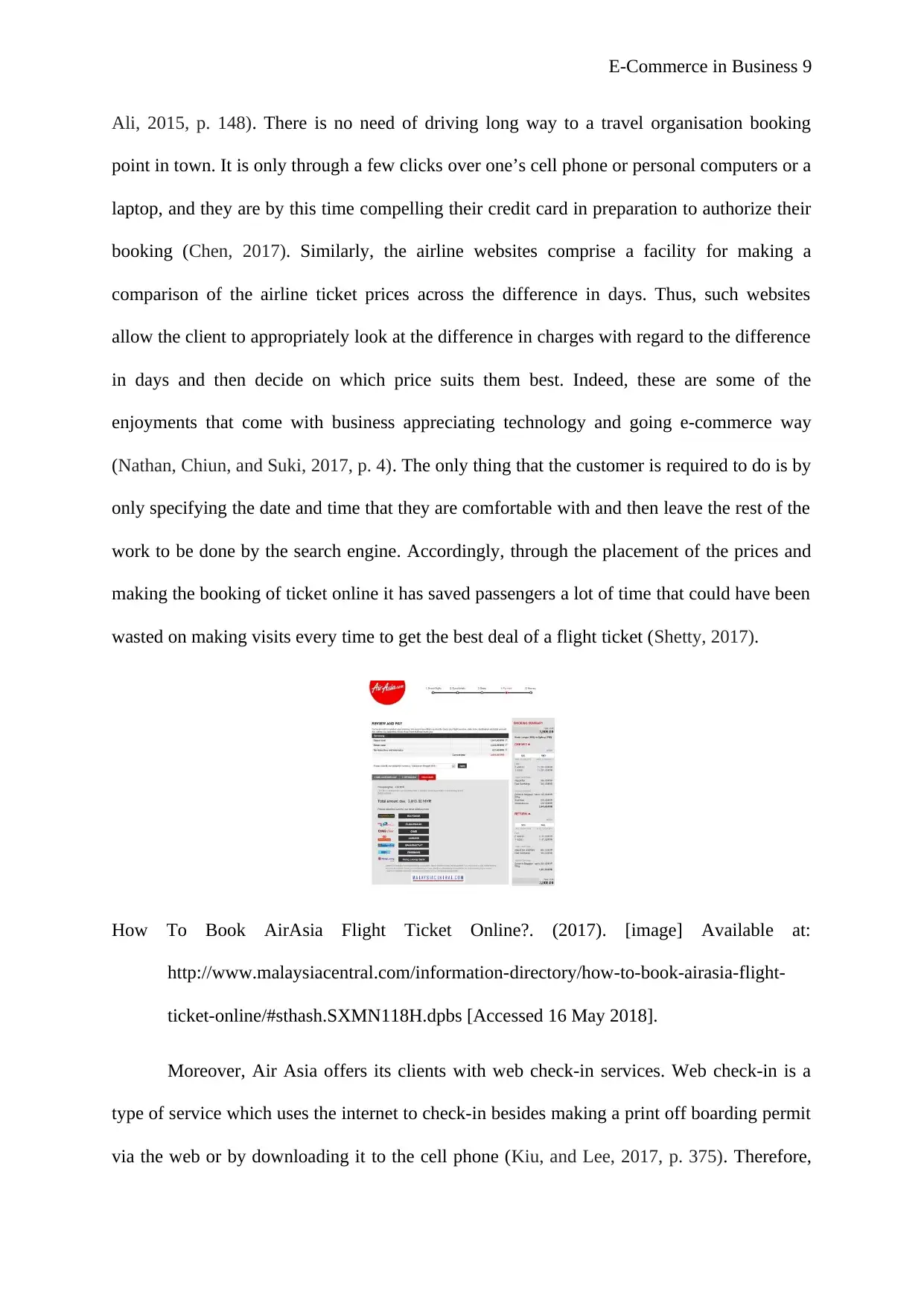
E-Commerce in Business 9
Ali, 2015, p. 148). There is no need of driving long way to a travel organisation booking
point in town. It is only through a few clicks over one’s cell phone or personal computers or a
laptop, and they are by this time compelling their credit card in preparation to authorize their
booking (Chen, 2017). Similarly, the airline websites comprise a facility for making a
comparison of the airline ticket prices across the difference in days. Thus, such websites
allow the client to appropriately look at the difference in charges with regard to the difference
in days and then decide on which price suits them best. Indeed, these are some of the
enjoyments that come with business appreciating technology and going e-commerce way
(Nathan, Chiun, and Suki, 2017, p. 4). The only thing that the customer is required to do is by
only specifying the date and time that they are comfortable with and then leave the rest of the
work to be done by the search engine. Accordingly, through the placement of the prices and
making the booking of ticket online it has saved passengers a lot of time that could have been
wasted on making visits every time to get the best deal of a flight ticket (Shetty, 2017).
How To Book AirAsia Flight Ticket Online?. (2017). [image] Available at:
http://www.malaysiacentral.com/information-directory/how-to-book-airasia-flight-
ticket-online/#sthash.SXMN118H.dpbs [Accessed 16 May 2018].
Moreover, Air Asia offers its clients with web check-in services. Web check-in is a
type of service which uses the internet to check-in besides making a print off boarding permit
via the web or by downloading it to the cell phone (Kiu, and Lee, 2017, p. 375). Therefore,
Ali, 2015, p. 148). There is no need of driving long way to a travel organisation booking
point in town. It is only through a few clicks over one’s cell phone or personal computers or a
laptop, and they are by this time compelling their credit card in preparation to authorize their
booking (Chen, 2017). Similarly, the airline websites comprise a facility for making a
comparison of the airline ticket prices across the difference in days. Thus, such websites
allow the client to appropriately look at the difference in charges with regard to the difference
in days and then decide on which price suits them best. Indeed, these are some of the
enjoyments that come with business appreciating technology and going e-commerce way
(Nathan, Chiun, and Suki, 2017, p. 4). The only thing that the customer is required to do is by
only specifying the date and time that they are comfortable with and then leave the rest of the
work to be done by the search engine. Accordingly, through the placement of the prices and
making the booking of ticket online it has saved passengers a lot of time that could have been
wasted on making visits every time to get the best deal of a flight ticket (Shetty, 2017).
How To Book AirAsia Flight Ticket Online?. (2017). [image] Available at:
http://www.malaysiacentral.com/information-directory/how-to-book-airasia-flight-
ticket-online/#sthash.SXMN118H.dpbs [Accessed 16 May 2018].
Moreover, Air Asia offers its clients with web check-in services. Web check-in is a
type of service which uses the internet to check-in besides making a print off boarding permit
via the web or by downloading it to the cell phone (Kiu, and Lee, 2017, p. 375). Therefore,
⊘ This is a preview!⊘
Do you want full access?
Subscribe today to unlock all pages.

Trusted by 1+ million students worldwide
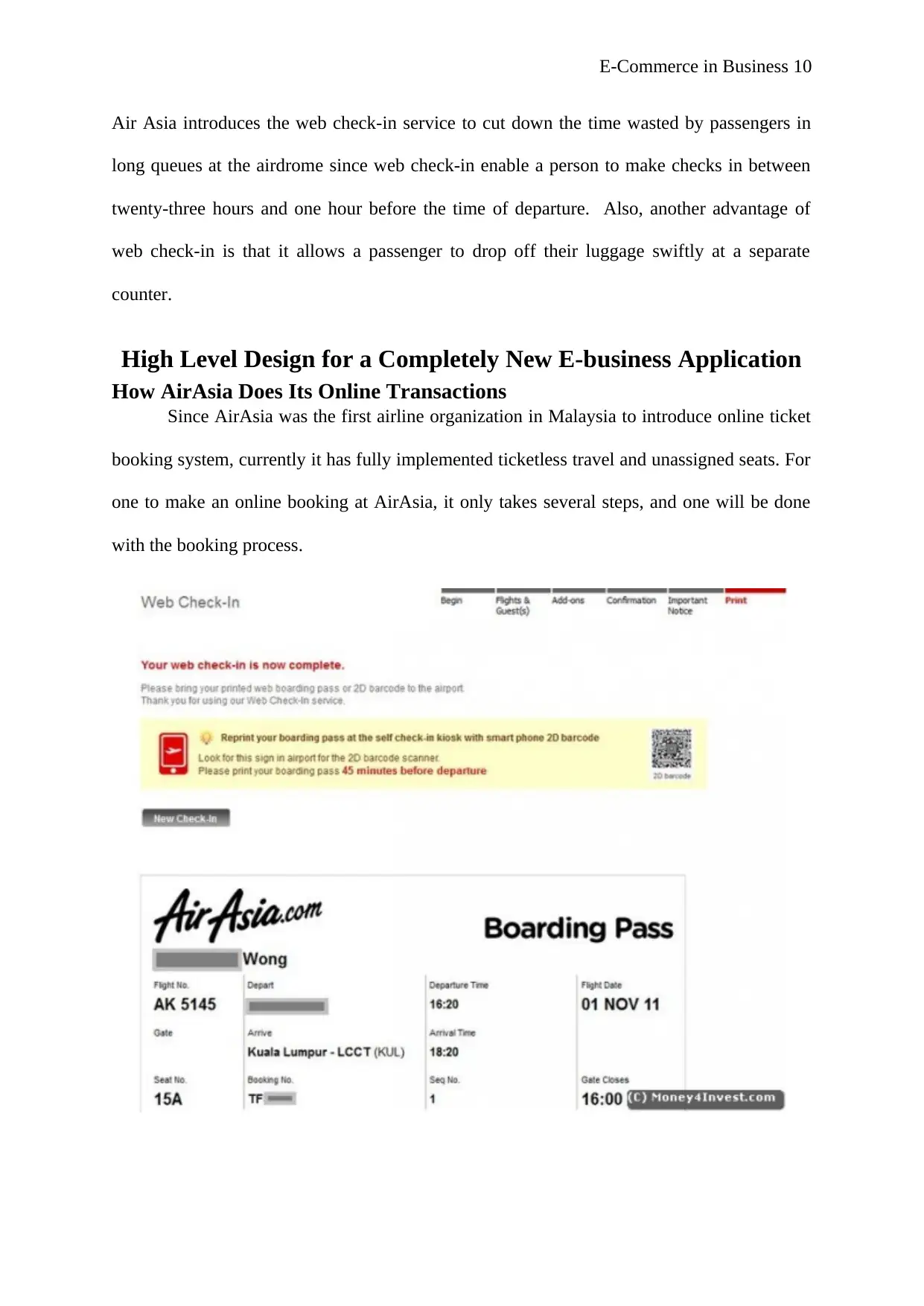
E-Commerce in Business 10
Air Asia introduces the web check-in service to cut down the time wasted by passengers in
long queues at the airdrome since web check-in enable a person to make checks in between
twenty-three hours and one hour before the time of departure. Also, another advantage of
web check-in is that it allows a passenger to drop off their luggage swiftly at a separate
counter.
High Level Design for a Completely New E-business Application
How AirAsia Does Its Online Transactions
Since AirAsia was the first airline organization in Malaysia to introduce online ticket
booking system, currently it has fully implemented ticketless travel and unassigned seats. For
one to make an online booking at AirAsia, it only takes several steps, and one will be done
with the booking process.
Air Asia introduces the web check-in service to cut down the time wasted by passengers in
long queues at the airdrome since web check-in enable a person to make checks in between
twenty-three hours and one hour before the time of departure. Also, another advantage of
web check-in is that it allows a passenger to drop off their luggage swiftly at a separate
counter.
High Level Design for a Completely New E-business Application
How AirAsia Does Its Online Transactions
Since AirAsia was the first airline organization in Malaysia to introduce online ticket
booking system, currently it has fully implemented ticketless travel and unassigned seats. For
one to make an online booking at AirAsia, it only takes several steps, and one will be done
with the booking process.
Paraphrase This Document
Need a fresh take? Get an instant paraphrase of this document with our AI Paraphraser
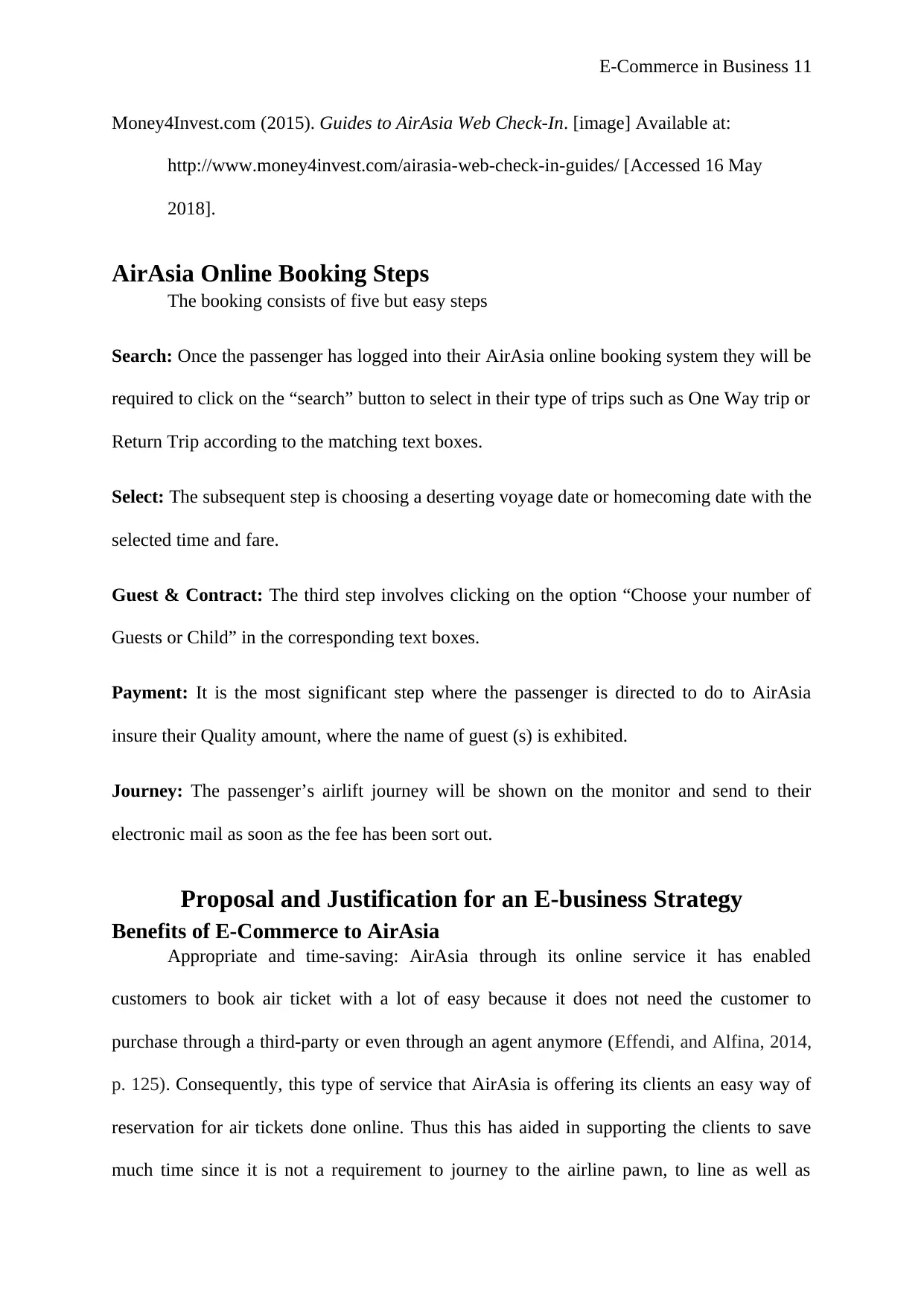
E-Commerce in Business 11
Money4Invest.com (2015). Guides to AirAsia Web Check-In. [image] Available at:
http://www.money4invest.com/airasia-web-check-in-guides/ [Accessed 16 May
2018].
AirAsia Online Booking Steps
The booking consists of five but easy steps
Search: Once the passenger has logged into their AirAsia online booking system they will be
required to click on the “search” button to select in their type of trips such as One Way trip or
Return Trip according to the matching text boxes.
Select: The subsequent step is choosing a deserting voyage date or homecoming date with the
selected time and fare.
Guest & Contract: The third step involves clicking on the option “Choose your number of
Guests or Child” in the corresponding text boxes.
Payment: It is the most significant step where the passenger is directed to do to AirAsia
insure their Quality amount, where the name of guest (s) is exhibited.
Journey: The passenger’s airlift journey will be shown on the monitor and send to their
electronic mail as soon as the fee has been sort out.
Proposal and Justification for an E-business Strategy
Benefits of E-Commerce to AirAsia
Appropriate and time-saving: AirAsia through its online service it has enabled
customers to book air ticket with a lot of easy because it does not need the customer to
purchase through a third-party or even through an agent anymore (Effendi, and Alfina, 2014,
p. 125). Consequently, this type of service that AirAsia is offering its clients an easy way of
reservation for air tickets done online. Thus this has aided in supporting the clients to save
much time since it is not a requirement to journey to the airline pawn, to line as well as
Money4Invest.com (2015). Guides to AirAsia Web Check-In. [image] Available at:
http://www.money4invest.com/airasia-web-check-in-guides/ [Accessed 16 May
2018].
AirAsia Online Booking Steps
The booking consists of five but easy steps
Search: Once the passenger has logged into their AirAsia online booking system they will be
required to click on the “search” button to select in their type of trips such as One Way trip or
Return Trip according to the matching text boxes.
Select: The subsequent step is choosing a deserting voyage date or homecoming date with the
selected time and fare.
Guest & Contract: The third step involves clicking on the option “Choose your number of
Guests or Child” in the corresponding text boxes.
Payment: It is the most significant step where the passenger is directed to do to AirAsia
insure their Quality amount, where the name of guest (s) is exhibited.
Journey: The passenger’s airlift journey will be shown on the monitor and send to their
electronic mail as soon as the fee has been sort out.
Proposal and Justification for an E-business Strategy
Benefits of E-Commerce to AirAsia
Appropriate and time-saving: AirAsia through its online service it has enabled
customers to book air ticket with a lot of easy because it does not need the customer to
purchase through a third-party or even through an agent anymore (Effendi, and Alfina, 2014,
p. 125). Consequently, this type of service that AirAsia is offering its clients an easy way of
reservation for air tickets done online. Thus this has aided in supporting the clients to save
much time since it is not a requirement to journey to the airline pawn, to line as well as
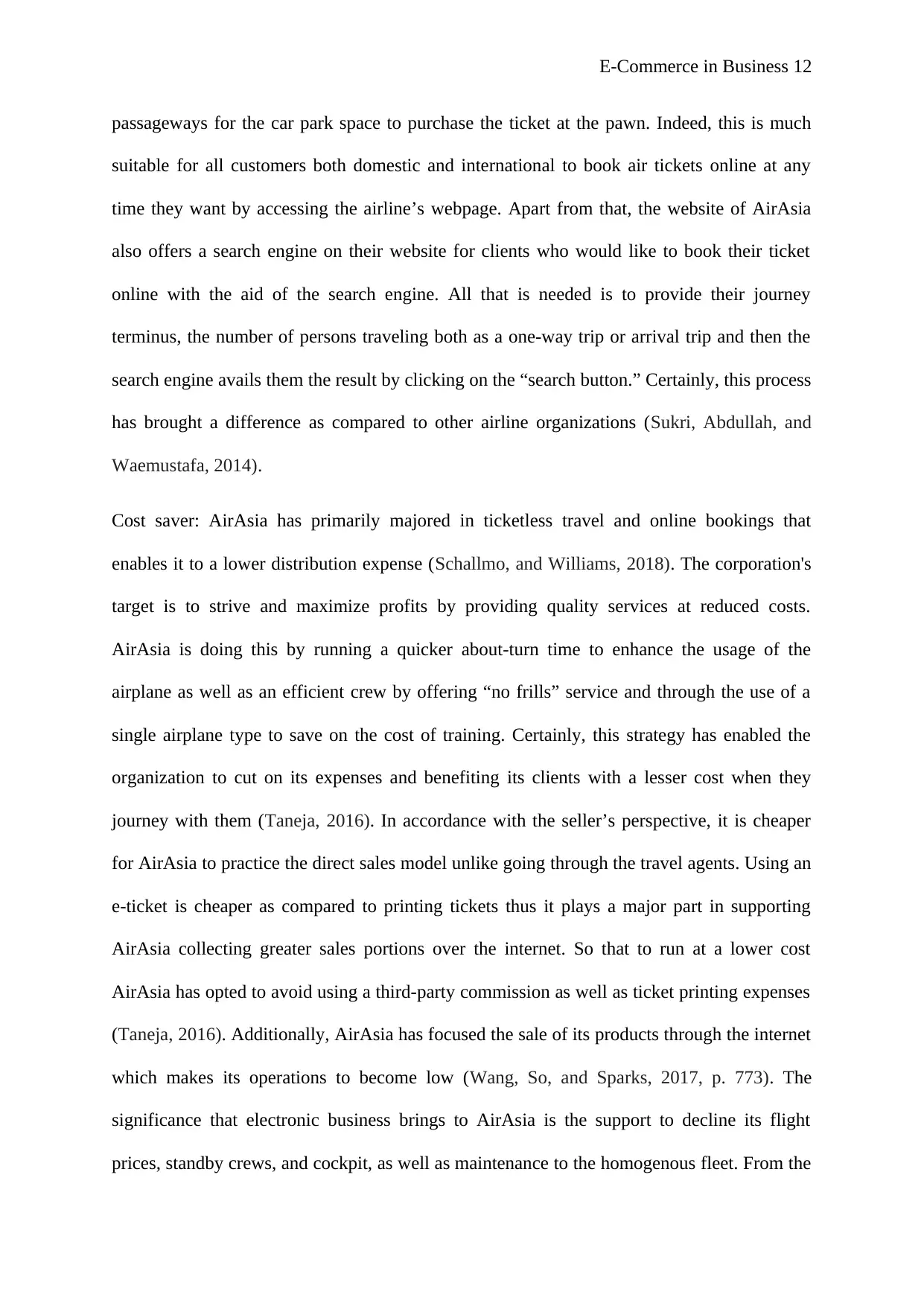
E-Commerce in Business 12
passageways for the car park space to purchase the ticket at the pawn. Indeed, this is much
suitable for all customers both domestic and international to book air tickets online at any
time they want by accessing the airline’s webpage. Apart from that, the website of AirAsia
also offers a search engine on their website for clients who would like to book their ticket
online with the aid of the search engine. All that is needed is to provide their journey
terminus, the number of persons traveling both as a one-way trip or arrival trip and then the
search engine avails them the result by clicking on the “search button.” Certainly, this process
has brought a difference as compared to other airline organizations (Sukri, Abdullah, and
Waemustafa, 2014).
Cost saver: AirAsia has primarily majored in ticketless travel and online bookings that
enables it to a lower distribution expense (Schallmo, and Williams, 2018). The corporation's
target is to strive and maximize profits by providing quality services at reduced costs.
AirAsia is doing this by running a quicker about-turn time to enhance the usage of the
airplane as well as an efficient crew by offering “no frills” service and through the use of a
single airplane type to save on the cost of training. Certainly, this strategy has enabled the
organization to cut on its expenses and benefiting its clients with a lesser cost when they
journey with them (Taneja, 2016). In accordance with the seller’s perspective, it is cheaper
for AirAsia to practice the direct sales model unlike going through the travel agents. Using an
e-ticket is cheaper as compared to printing tickets thus it plays a major part in supporting
AirAsia collecting greater sales portions over the internet. So that to run at a lower cost
AirAsia has opted to avoid using a third-party commission as well as ticket printing expenses
(Taneja, 2016). Additionally, AirAsia has focused the sale of its products through the internet
which makes its operations to become low (Wang, So, and Sparks, 2017, p. 773). The
significance that electronic business brings to AirAsia is the support to decline its flight
prices, standby crews, and cockpit, as well as maintenance to the homogenous fleet. From the
passageways for the car park space to purchase the ticket at the pawn. Indeed, this is much
suitable for all customers both domestic and international to book air tickets online at any
time they want by accessing the airline’s webpage. Apart from that, the website of AirAsia
also offers a search engine on their website for clients who would like to book their ticket
online with the aid of the search engine. All that is needed is to provide their journey
terminus, the number of persons traveling both as a one-way trip or arrival trip and then the
search engine avails them the result by clicking on the “search button.” Certainly, this process
has brought a difference as compared to other airline organizations (Sukri, Abdullah, and
Waemustafa, 2014).
Cost saver: AirAsia has primarily majored in ticketless travel and online bookings that
enables it to a lower distribution expense (Schallmo, and Williams, 2018). The corporation's
target is to strive and maximize profits by providing quality services at reduced costs.
AirAsia is doing this by running a quicker about-turn time to enhance the usage of the
airplane as well as an efficient crew by offering “no frills” service and through the use of a
single airplane type to save on the cost of training. Certainly, this strategy has enabled the
organization to cut on its expenses and benefiting its clients with a lesser cost when they
journey with them (Taneja, 2016). In accordance with the seller’s perspective, it is cheaper
for AirAsia to practice the direct sales model unlike going through the travel agents. Using an
e-ticket is cheaper as compared to printing tickets thus it plays a major part in supporting
AirAsia collecting greater sales portions over the internet. So that to run at a lower cost
AirAsia has opted to avoid using a third-party commission as well as ticket printing expenses
(Taneja, 2016). Additionally, AirAsia has focused the sale of its products through the internet
which makes its operations to become low (Wang, So, and Sparks, 2017, p. 773). The
significance that electronic business brings to AirAsia is the support to decline its flight
prices, standby crews, and cockpit, as well as maintenance to the homogenous fleet. From the
⊘ This is a preview!⊘
Do you want full access?
Subscribe today to unlock all pages.

Trusted by 1+ million students worldwide
1 out of 18
Related Documents
Your All-in-One AI-Powered Toolkit for Academic Success.
+13062052269
info@desklib.com
Available 24*7 on WhatsApp / Email
![[object Object]](/_next/static/media/star-bottom.7253800d.svg)
Unlock your academic potential
Copyright © 2020–2025 A2Z Services. All Rights Reserved. Developed and managed by ZUCOL.





